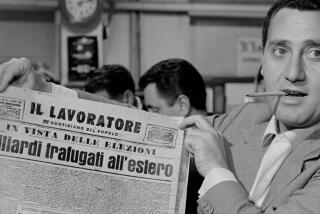Tonino Delli Colli, 81; Innovative Director of Photography
- Share via
Tonino Delli Colli, the versatile Italian cinematographer whose work ranged from Sergio Leone’s classic spaghetti western “The Good, the Bad and the Ugly” to Roberto Benigni’s “Life is Beautiful,” has died. He was 81.
Delli Colli died Aug. 16 at his home in Rome of a heart attack.
In a long career that included more than 130 films, Delli Colli worked with top directors of the Italian cinema -- including not only Leone and Benigni but Pier Paolo Pasolini, Roberto Rosselini and Federico Fellini.
The cinematographer earned four David di Donatello awards -- Italy’s equivalent of the Academy Award -- for “The Good, the Bad and the Ugly” (1966), “Once Upon a Time in America” (1984), “The Name of the Rose” (1986) and “Life is Beautiful” (1997).
“In my work, I’ve always tried to illuminate the stories that are being told, using the simplicity of my feelings and the instinct that has guided me,” Delli Colli said this year after receiving the American Society of Cinematographers’ international achievement award.
Delli Colli helped pioneer post-World War II neorealist cinema, which emphasized shooting on location and the use of natural light. Practicality helped form the artistic style, he often pointed out -- in war-torn Italy, there was little money for elaborate studios or artificial lighting.
He originally shot only in black and white, which emphasized the gritty realism of the genre. But he made Italy’s first color film, “Toto a colori,” in 1952 and became adept at painting the screen in colors that reflected the mood of the picture.
Whether shooting in color or not, Delli Colli was a master at creating special atmospheres with lighting and -- especially for Leone -- mixing long shots and extreme close-ups to emphasize individual characters.
Delli Colli was particularly associated with Pasolini after volunteering to work for scale on “Accattone!” (1961) in order to join the daring new director. Their collaboration lasted through 11 films over 15 years, until Pasolini’s death in 1975.
“We provoked a minor revolution on a technical level [by using] a lens which nobody wanted at the time, a 35-140 millimeter ... joined to an Arriflex, a camera that wasn’t used in Italy,” Delli Colli said in the book “Making Pictures: A Century of European Cinematography.” “We certainly inaugurated a very distinctive photographic style.”
Born Antonio Delli Colli in Rome on Nov. 20, 1923, he quit school after junior high. Through his father, a film laboratory worker, he got a job at Cinecitta Studios in 1938. Asked whether he wanted to work in the sound department or with cameramen, he chose the latter, even though he knew nothing about cameras.
The teenage Delli Colli began as an assistant to Mario Albertelli and first earned his own credit as cinematographer for “Finalmente si” (1943).
“Life is Beautiful,” which won three Academy Awards, was Delli Colli’s final film.
Delli Colli is survived by his son, Stefano, of Rome.
More to Read
Only good movies
Get the Indie Focus newsletter, Mark Olsen's weekly guide to the world of cinema.
You may occasionally receive promotional content from the Los Angeles Times.








